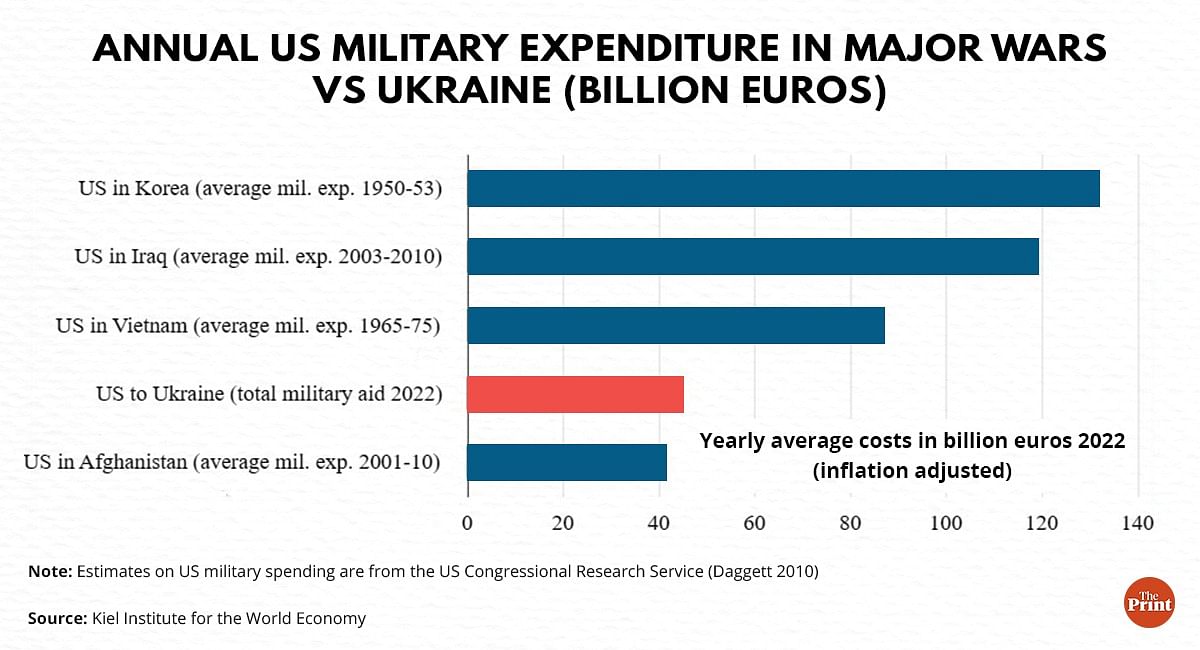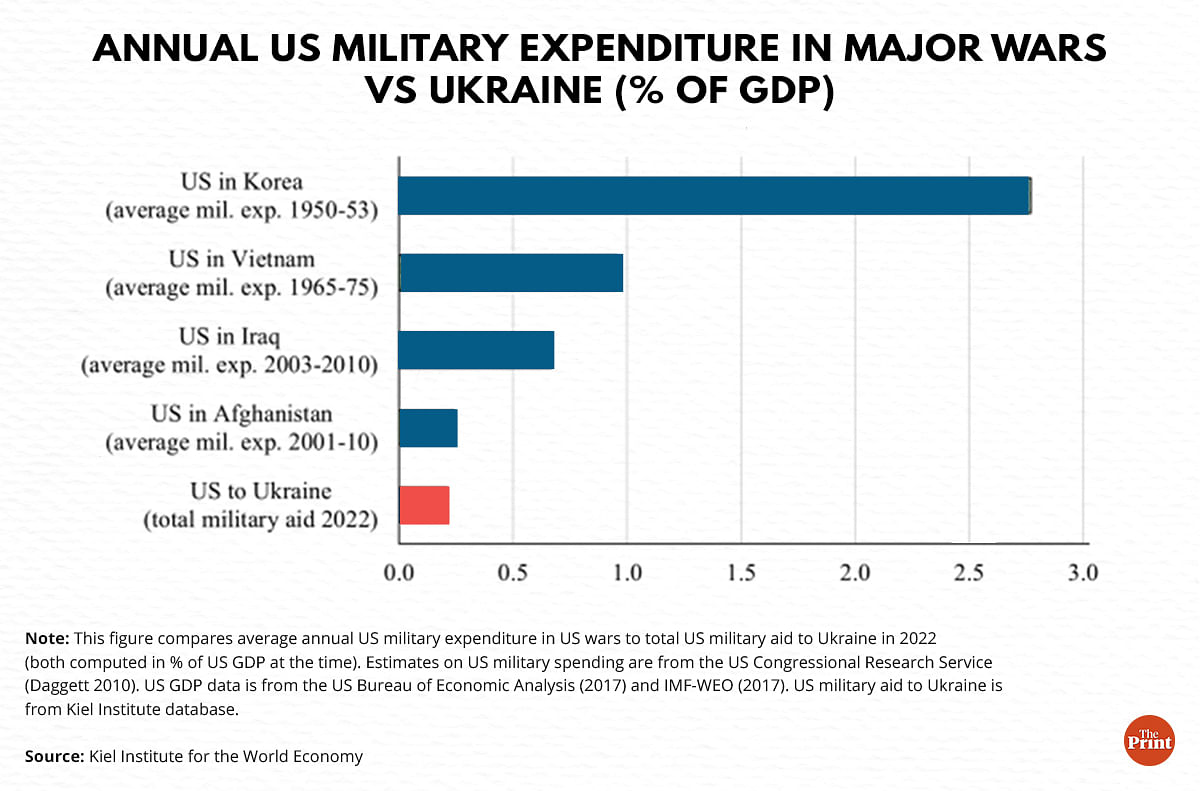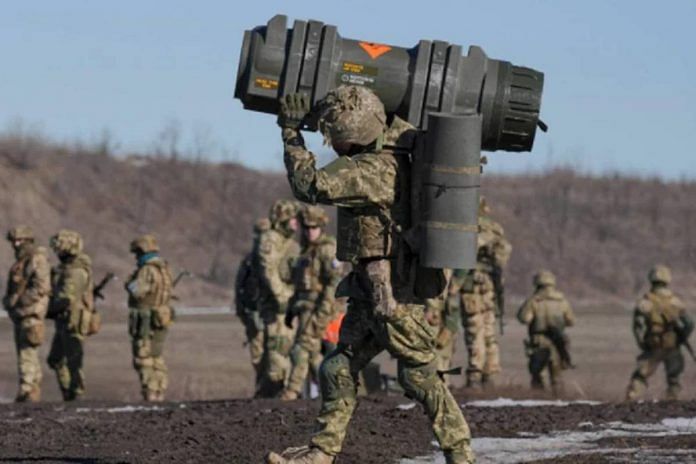New Delhi: Within just a year of the beginning of a full-scale Russia-Ukraine conflict and with no troops on the ground, the US has spent in Ukraine more than half the military aid it did on an annual average in Vietnam during the 1965-75 war period, a study by Germany-based Kiel Institute for the World Economy (IfW) has found.
Founded in 1914, IfW is an independent non-profit that researches the drivers and impact of global economic activity.
The study, released last month as part of IfW’s Ukraine support tracker, looked at military aid to Ukraine over a one-year period from 24 January, 2022, (the end of diplomatic relations between Russia and Ukraine) to 15 January, 2023. Russia started a full-scale invasion of Ukraine on 24 February, 2022.
Adjusting for inflation, the study showed that US military expenditure in Ukraine is €44.34 billion (approximately $47 billion) compared to an average annual military expenditure of €86.55 billion (approximately $92 billion) in Vietnam.
In terms of percentage of Gross Domestic Product (GDP), US military aid to Ukraine has already reached a quarter of its expenditure in Vietnam, according to the study.
It found that US military spending in Ukraine is 0.21 per cent of its GDP compared to the annual average in Vietnam, which was 0.96 per cent of GDP (at the time) during 1965-75.

This calculation is perhaps more insightful as it accounts for the change in economic power of the US over the years.
The study’s findings come as intense fighting continues between Ukraine and Russia. While Ukraine’s soldiers are firing up to 10,000 artillery shells a day, the US and its allies have started sending military tanks to capital Kyiv.
Reports indicate that the amount of ammunition being consumed in the Ukraine war has exceeded all estimates, so much so that it is beginning to put pressure on production and supply chains and drain western inventories.
Also read: Russia cannot be allowed to wage war against Ukraine with impunity, say US, allies
Military aid to Ukraine vs Afghanistan
The IfW study primarily focuses on quantifying military, financial and humanitarian aid promised by governments to Ukraine over the past year. However, it also includes a chapter on historical comparisons of US military aid. These include not just the Vietnam War but also the Korean War, Afghanistan War and the Iraq War.
To ascertain the military costs of previous conflicts and their length, the study relies on a 2010 US Congressional Research Service (CRS) report. For the Ukraine data, it uses its own database.
A major finding from the study is that US military aid to Ukraine exceeds the yearly average of military expenditure during the Afghanistan conflict.
US military spending in Ukraine is €44.34 billion (approximately $47 billion) compared to an average annual military expenditure in Afghanistan of €41.36 billion (approximately $44 billion), says the study.
“If you look at annual averages, you could say that the US has spent similar amounts in both wars,” one of the study’s researchers, Andre Frank, confirmed to ThePrint.
It is important to note that this finding looks at the yearly average of military expenditure in Afghanistan, and not the total expenditure over the length of the conflict.
However, a key point of contention could be that the study considers the Afghanistan War as a 10-year conflict from 2001 to 2010 despite American troops only withdrawing from the country in August 2021.
The study’s researchers argue that this is because of limitations of the 2010 CRS report, adding that it wouldn’t make “much” difference to the overall analysis.
“We use data from the 2010 CRS report. Due to obvious time limitations, they do not have data on expenditures after 2010,” explained Frank.
“While we could add cost estimates from other sources, we decided that it was best to stick to one source and be more consistent. The overall picture would not change much if we include additional years,” he added.
The comparison between the Ukraine and Afghanistan war is different when looked at as a percentage of US GDP.
The study found that US military spending in Afghanistan, on an annual average, was 0.25 per cent of GDP compared to 0.21 per cent of GDP in Ukraine.

For this calculation, the study used GDP data from the US Bureau of Economic Analysis and the International Monetary Fund.
How Ukraine war is accelerating global military spending
The Russia-Ukraine war, and arguably tensions between the US and countries like Russia and China, have impacted global military spending in a significant way.
In recent weeks, China has increased defence spending by 7.2 per cent while the UK has announced it would increase military funding by $6 billion over the next two years in the wake of Russia’s invasion of Ukraine and the “epoch-defining challenge” posed by China.
As analyst group Fortune Business Insights puts it, the Russia-Ukraine war has brought the world under the influence of a “new wave of accelerating defence spending” and has led to a boom in defence business in the US and Europe.
A recent CNN report, titled ‘Ukraine is burning through ammunition faster than the US and NATO can produce it. Inside the Pentagon’s plan to close the gap’, points out how a key ammunition plant in Pennsylvania is undergoing a major expansion to keep up with the demand for arsenal and rebuild the US’ own military stockpile.
Reports have also stated that the 10 largest weapons manufacturers in the US and Europe increased their sales by 7.5 per cent in the last quarter of 2022 due to growing demand for ammunition. More so, German company Rheinmetall is looking to acquire Spain’s main ammunition manufacturer, Expal, for around €1.2 billion — more than double what it was worth two years ago.
Last month, NATO Secretary-General Jens Stoltenberg had urged member states to commit at least 2 per cent of their GDP on defense by a set date. Recent NATO estimates show that 10 member states had spent 2 per cent or more on defence in 2022.
“These numbers show that while the advanced states have steadfastly refused to provide financial resources to meet the developmental objectives, as well as for reversing the trend of global warming, they have no qualms in spending hundreds of billions for supporting the destructive armament industry,” Biswajit Dhar, former professor at JNU’s Centre for Economic Studies and Planning, told ThePrint.
(Edited by Nida Fatima Siddiqui)
Also read: India world’s largest arms importer in 2018-2022. Ukraine 3rd largest in 2022: SIPRI data



